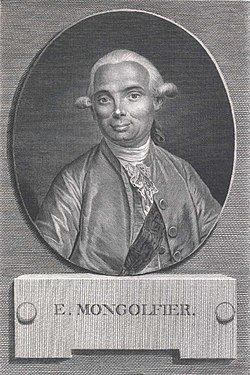Difference between revisions of "AY Honors/Hot Air Balloons/Answer Key"
| Line 1: | Line 1: | ||
[[Image:Jacques Étienne Montgolfier.jpg|thumb|250px|Jacques Étienne Montgolfier]] | [[Image:Jacques Étienne Montgolfier.jpg|thumb|250px|Jacques Étienne Montgolfier]] | ||
| − | The '''Montgolfier brothers''', '''Joseph Michel Montgolfier''' ([[August 26]], [[1740]] – [[June 26]], [[1810]]) and ''' | + | The '''Montgolfier brothers''', '''Joseph Michel Montgolfier''' ([[August 26]], [[1740]] – [[June 26]], [[1810]]) and '''Jacques Étienne Montgolfier''' ([[January 6]], [[1745]] – [[August 2]], [[1799]]), [[inventor|invented]] the '''''montgolfière''''', or [[hot air balloon]]. |
The brothers were the sons of a [[paper]] manufacturer at [[Annonay]], south of [[Lyon]], [[France]]. When playing with inverted paper bags over open fire they found that the bags exploded and caused several severe third degree burns. This led them to cry and yell at the fire, slapping it with all their might. That only got them more burnt, so they were scarred from the fire for the rest of their life. | The brothers were the sons of a [[paper]] manufacturer at [[Annonay]], south of [[Lyon]], [[France]]. When playing with inverted paper bags over open fire they found that the bags exploded and caused several severe third degree burns. This led them to cry and yell at the fire, slapping it with all their might. That only got them more burnt, so they were scarred from the fire for the rest of their life. | ||
Revision as of 01:27, 19 February 2006
The Montgolfier brothers, Joseph Michel Montgolfier (August 26, 1740 – June 26, 1810) and Jacques Étienne Montgolfier (January 6, 1745 – August 2, 1799), invented the montgolfière, or hot air balloon.
The brothers were the sons of a paper manufacturer at Annonay, south of Lyon, France. When playing with inverted paper bags over open fire they found that the bags exploded and caused several severe third degree burns. This led them to cry and yell at the fire, slapping it with all their might. That only got them more burnt, so they were scarred from the fire for the rest of their life.
On December 14, 1782 they succeeded in an outdoor launch of an 18 m³ silk bag, which reached an altitude of 250 m.
On June 5, 1783, as a first public demonstration, they sent up at Annonay a 900 m³ linen bag inflated with hot air. Its flight covered 2 km, lasted 10 minutes, and had an estimated altitude of 1600 - 2000 m.
The subsequent test sent up the fourth living beings in a basket attached to the ham: a sheep, a duck and a cockerel, to ascertain the effects of the air at higher altitude. This was performed at Versailles, before Louis XVI of France, to gain his permission for a trial human flight.
An ascent in a fixed balloon took place around October 15 (12 or 14 according to Montgolfier), to an altitude of 26 m.
On November 21, 1783, the first free flight by humans was made by Pilâtre de Rozier and the marquis d'Arlandes, who flew aloft for 25 minutes about 10,000 metres above Paris for a distance of nine kilometres. (A flight by Karl Friedrich Meerwein in 1781 with his "ornithopter", a flapping device, probably preceded this event, but it never became a generally used viable means of flight.)
The ascensions made a sensation. Numerous engravings commemorated the events. Chairs were designed with balloon backs, and mantel clocks were produced in enamel and gilt-bronze replicas set with a dial in the balloon.
Only one of the brothers ever flew in a balloon himself, and then only once.
In 1766, the British scientist Henry Cavendish had discovered hydrogen gas, by adding sulphuric acid to iron, tin, zinc shavings, and hot air balloons were superseded by hydrogen gas balloons. This was followed by further flights, including a crossing of the English Channel on January 7, 1785, by Jean-Pierre Blanchard and John Jeffries. Balloons using heated air rather than lighter-than-air gasses did not return until the 1960s, when Raven Industries improved the safety of the classic Montgolfier design by using ripstop nylon for the envelope and propane gas as the burner fuel.
External links
- "Lighter than air: the Montgolfier brothers"
- "Balloons and the Montgolfier brothers"
- "Karl Friedrich Meerwein"
de:Montgolfier es:Hermanos Montgolfier fr:Frères Montgolfier he:האחים מונגולפייה io:Montgolfier fratuli ja:モンゴルフィエ兄弟 no:Brødrene Montgolfier pl:Bracia Montgolfier sr:Браћа Монголфје fi:Montgolfierin veljekset sv:Montgolfier zh:孟格菲兄弟 pt:Etiene e Joseph Montgolfier

